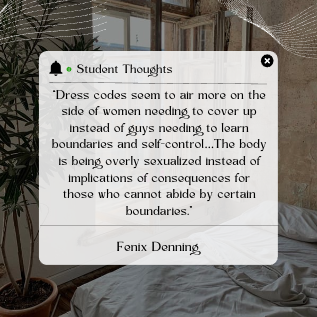Public school dress codes: An old yet necessary conversation
Girls at Arvada West of all shapes, sizes, and colors are at risk of being dress-coded for what could be considered ‘inappropriate.’
Dress codes in public education have long since been a spark of controversy, a long winded-debate. It’s an old topic we keep rehashing, but indeed a topic that must continue. Female students in particular have said so much on the topic of dress codes and their close ties to sexism. We have yet to see changes, instead, sexism, starting from administration and trickling down to teachers, who are hell-bent on keeping out of date and sexist rules and regulations.
When polled, 50% of Arvada West students say they have been dress-coded, and an additional 90% say they have seen somebody be dress-coded. These numbers show dress code rules and regulations are no longer modern or current. Fair rules and regulations throughout the school should evolve as our society does.
As a new generation enters the education system, limits and rules are being pushed like never before. Changing the dress code comes down to what we as a society define as ‘indecent.’
The definition of decency, according to Oxford’s Dictionary is, “behavior that conforms to accepted standards of morality or respectability.”
Geree Santarelli, the school principal has thoughts on decency and what it means to have a dress code, “I don’t know if it’s decency. To me it’s comfortability, it’s professionalism.” She also recognizes there are certain clothes for certain environments. “Today I’m in jeans, tennis shoes, and a shirt. If I were going to the Ed Center today, with a superintendent, I would not be dressed this way. There’s a time and a place…It’s hard for me to say, is it decent to show your tummy? To me? I’m like, ‘Okay, show your tummy.’ It’s not that big a deal to me.”
Some students might make the argument that since Santarelli enforces the dress code and has her staff do the same, she’s demonstrating that she agrees with the dress code. That if she truly didn’t care she would change the rules. However, surprisingly, these decisions aren’t up to Santarelli.
“We take our policies and procedures to our school accountability committee. It’s a parent group that advises me as the principal and looks at our policies and procedures…Last year we had a lot of concerns about the dress code from people, parents, everything. So we took it to the accountability committee.”
As a school, we must examine where we place blame for our policies and procedures. What matters to us as a student body and how do we communicate respectively and to the right people?
However, we still run into the same issue of how we address the dress code and enforce it. Some students don’t believe our dress code displays ‘decency’ and how it fits into modern society.
Aaron Nyquist, a sophomore, believes banning certain things isn’t productive, “No one’s going to be distracted because they see someone else’s shoulders. I’m just saying it’s flawed because the dress code is supposed to make sure you don’t get distracted but no one’s going to be distracted in the modern age now, if someone’s wearing a crop top or thin straps.”
Having a dress code may seem like a simple enough concept, but there’s a lot to consider when creating and enforcing such policies. Dress codes were originally designed to promote a safe learning environment and minimize distractions, but as students charged with violating one can attest, adhering to such detailed policies can be more distracting than the distraction they were designed to prevent.
An article by Dani R, a student journalist in Nevada, says it best. “It’s always ‘cover up, you’ll distract the boys’ and never, ‘stop looking’. Women’s shoulders, knees, or stomach, should not have to be covered up on a hot summer day due to men being ‘distracted’. School dress code has been a thing for as long as we can remember. The dress code is biased and sexist: boys wear tank tops, have holes in their jeans and face no consequences, but as soon as a girl wears a tank top, she’s forced to change into an over-sized shirt or forced to go home.”
While banning clothes related to violence or gang affiliation seem reasonable, rules banning things such as headbands seem downright ridiculous. Jeffco Schools itself doesn’t have many detailed rules other than saying students must wear close-toed shoes and avoid wearing clothing of, “Any manner of grooming or apparel, including clothing, jewelry, emblems and/or badges which by virtue of color, arrangement, trademark, or other attribute is associated with, or denotes membership in or affiliation with, any gang.”
However, A-West itself has a Student Handbook students can find under a similar section on the website. This handbook includes rules such as, “No headgear is allowed in the building, which includes but is not limited to hats, headbands, etc,” and “All students are not allowed to wear items of clothing that reveal bellies, breasts, butts or underwear.”
This dress code may appear acceptable but on closer inspection, a student may find themselves noticing that despite the handbook saying ‘All students’ must follow these rules, many staff members only seem to discipline students which would be considered female, and even there have been instances where females with certain body shapes seem to be under more scrutiny than others.

Fenix Denning, sophomore, agrees, “Dress codes seem to air more on the side of women needing to cover up instead of guys needing to learn boundaries and self-control…The body is being overly sexualized instead of implications of consequences for those who cannot abide by certain boundaries. These can also be seen when a small-figured girl can get away with crop tops and short skirts and for those with a ‘fuller figure’ with those same outfits are seen as too revealing or inappropriate.”
Outside of the rules themselves, their enforcement seems to be out of proportion. Sophomore Class President, Isabelle Liberatore can attest to this, “I think that many people don’t get treated equally with the dress code. I think different body types and different genders are disciplined differently when it comes to dress code regardless of what is being dress-coded…I’ve first-hand noticed…some of my plus-sized friends have been dress-coded way more than some of my friends with more socially accepted body types.”
On top of all of this, outside of plus-sized individuals, students of color and students in the LGBT+ community also face further discrimination from the dress code.
In an article by ACLU, “Such policies also may punish LGBTQ+ students for not conforming with rigid and binary gender norms about proper behavior and appearance. Moreover, students of color – and especially Black girls and other girls of color – are disproportionately targeted for dress code enforcement because of intersecting race and gender stereotypes. Black girls, in particular, are often seen as less innocent and more adult-like, aggressive and threatening, and needing less support and protection – often known as the ‘adultification bias.’”
Again, this conversation is widely had, but it needs to be about doing something. In an interview with The Atlantic, Maggie Sunseri explains, “‘I’ve never seen a boy called out for his attire even though they also break the rules,’ says Sunseri, who last summer produced Shame: A Documentary on School Dress Code, a film featuring interviews with dozens of her classmates and her school principal, that explores the negative impact biased rules can have on girls’ confidence and sense of self. The documentary now has tens of thousands of YouTube views, while a post about the dress-code policy at her high school—Woodford County High—has been circulated more than 45,000 times on the Internet.”
This is an incredible example of how one high school student can make waves in his or her community by speaking out about issues in public education. A high school should be a safe place for students to learn, not only about math or science, but about themselves, and an important way of doing this for many students is self-expression through clothing. But students no longer have a safe space in education to do this.
Elora Chism, sophomore, can agree. “I think the dress code could be implemented in a way that doesn’t objectify people. My body shouldn’t be labeled as a distraction…I don’t understand why I can go out anywhere else and no one has a problem with my outfit but as soon as I enter a school it’s a big issue. It just makes people feel self-conscious and I think that takes away from learning more than the actual dress code.”
Santarelli has some views on this that may surprise students. “We had redesigned it a bit, basically to keep it more student-focused, not male, female, just student-focused. What are the things as a student we wanna see at Arvada West High School? Then we took it to [the school accountability committee] and they said yes or no to the dress code. I truly believed that we would have gone away with the ‘keep your stomach covered,’ kind of thing, but the committee did not want them.”
So here’s what needs to happen: change the dress code and remove pieces that hypersexualize students unnecessarily. These rules are out-of-date and unhelpful and need to be changed. This is what is necessary to make an impact on our student body and truly change the way things are run at A-West.
Our world has grown so much over thousands of years, but that doesn’t mean it needs to stop growing. Changes happen when people do things and make waves and express themselves. Students can actively decide to voice their opinions and make waves in their community.

Maci is a senior and a four-year member of The Westwind staff, now in her second year as Editor-in-Chief. She fell in love with journalism freshman year...



